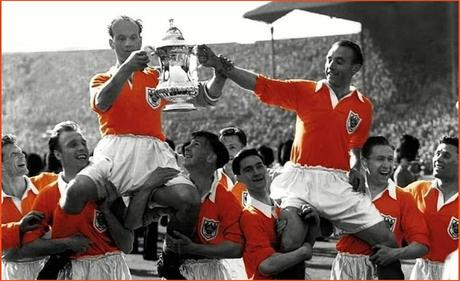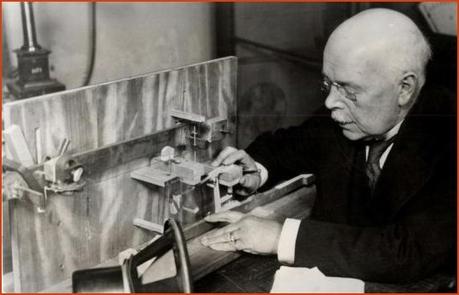*"Nanos gigantum humeris insidentes " translates literally as "dwarves mounted on the shoulders of giants". It's a phrase normally attributed to Priscian (approx. 500 A.D.) and was well-known to scholars from medieval times onwards as a metaphor for the generational advance of intellectual knowledge or wisdom.
It was also referenced, famously, in a letter by Sir Isaac Newton in a self-deprecating attempt to explain his pre-eminence as a 17th century polymath and renaissance man: "If I have seen further, it is by standing on the shoulders of giants." Sir Isaac it was who formulated the basic laws of classical mechanics, known as Newton's First, Second and Third Laws of Motion (waiting for you just a decent web browser away).
The more scientifically-minded among you will know that during the course of the 19th and 20th centuries, the fundamental laws of thermodynamics were formulated as well. More standing on the shoulders of giants. And guess how many of those there are? That's right! They're known as the First, Second and Third Laws of Thermodynamics... except that subsequently another principle, which underlay them all, was found to be necessary (the fourth of three) which they opted to call the Zeroth Law. Strange but true.
We will return to the Third Law of Thermodynamics later, but with all this talk of shoulders and giants I couldn't pass up the opportunity to celebrate the fact that seventy years ago this week Blackpool FC won the 'greatest Cup Final' of all time at Wembley, beating Bolton Wanderers by 4 goals to 3. By the law of threes, it was Blackpool's third appearance in the Final (they'd lost the earlier two to Manchester United in 1948 and Newcastle United in 1951). Also by the law of threes, Stan Mortensen scored a hat-trick (the third ever player to do so in an FA Cup Final match), although our Wembley triumph has gone down in history as the Stanley Matthews final.

Wembley 2nd May 1953
I was three months old at the time and 3,000 miles away, but that game and that squad was the reason why as soon as football was on my radar (aged five), the team in tangerine was the only one for me, heroes all for a towering achievement. I have a framed rosette from that Final hanging on my living-room wall and I still get emotional every time I watch the game back on DVD. đŸ§ĄOkay, back to the advancement of scientific knowledge stuff. Walther Nernst, a German chemist, was building on the pioneering work of previous giants of the scientific world like Sadi Carnot, Rudolf Clausius and William Thomson, all renowned for their studies concerning heat, when just before World War I he developed his postulate that became the Third Law of Thermodynamics, stating that "A system's entropy approaches a constant value as its temperature approaches absolute zero ". Oh dear, I can sense your eyes glazing over, but stay with me. What you really need to know about Nernst is that he was buried three times. Now read on.
Walther Nernst 1864-1941
Born and raised in Prussia, he then went to university in Zurich and Berlin where he studied chemistry, was granted his doctorate at twenty-three, was a friend of Albert Einstein, devoted his life to the study of thermodynamics (the actual and theoretical properties of heat/cold and light/dark), was awarded the Nobel Prize for Chemistry in 1920, and was an outspoken opponent of Hitler and Nazism. It is said that Einstein was much influenced by and indebted to the theoretical and intellectual propositions made by "the great Nernst ". In his spare time Walther also invented the electric piano. And yes, after Nernst died in 1941, he was buried three times. The first was in Gau, where he had been living out his last few years. Later his remains were disinterred and re-buried in Berlin. Finally he was dug up once more and found his current resting-place in a cemetery at Gottingen, next to two other giants of German science (and fellow Nobel Prize winners) Max Planck and Max von Laue.I've tried to make my latest experimental poem vaguely topical. It was Walpurgisnacht at the beginning of this week (30th April), that night when witches supposedly consort with the forces of darkness. It precedes the May Day festival named after the 8th century Saint Walpurga (big in Germany but born in Devon actually), she who converted the heathen Hun to Christianity and is said to have banished witchcraft from their lands. On Walpurgisnacht allegedly "magical girls dance and spin to the powerful tune of the devil." It has become like a second Hallowe'en for German revellers. All it needed (in my imagination) was for three-times buried Walther Nernst, that maestro of heat and cold, light and dark, to rise one last time and perform a little experimental witch-defying magic of his own. If you're reading this poem on a mobile phone, you might want to turn your device sideways (to landscape mode). Cue Walpurgis night weirdness...
On Walther Nernst Demonstrating The Third Law Of Thermodynamics As A Cheap Party TrickWalpurgis night in Berlin's famous KĂźhlekeller, full of chilling ice bar revellers, vodka flowing, frantic dancers toe-to-toeing, teeth and underwear glowing white in ultraviolet light and Kristel spinning to perfection commanding everyone's attention, continuously circling seductive in the center of the dance-floor, exerting her field of powerful underworld magic on young Brandenburgers, levelling resistance minute by fatal minute to the point where souls begin to sway and slip away blank-eyed and careless of the cost - when suddenly Walther Nernst, impeccable in formal evening dress, materialises from a sublimating cloud of CO2, and like a latter-day saint commences his miraculous experiment on the assembly, slowing the motion down, dropping the temperature further by degrees, entropy in train, with thwarted Kristel enchained as heat, light, motion drain away. Then in engulfing darkness, knowing that her party's over, and right before everything stops for ever, spiteful words issue from her pretty witchy freezing blue lips: "Bastard! You think you're so clever, father, but you're an absolute zero!"

Thanks for reading, S ;-) Email ThisBlogThis!Share to TwitterShare to Facebook
